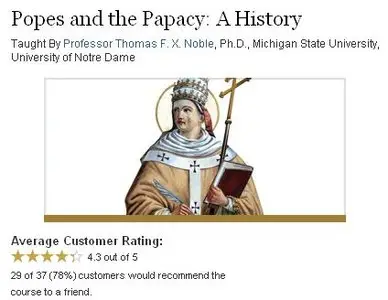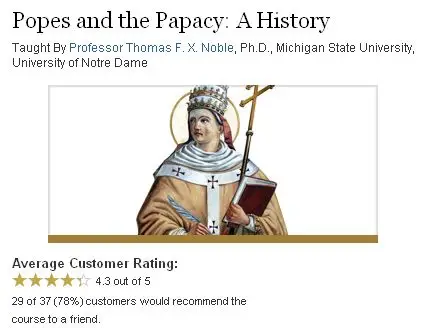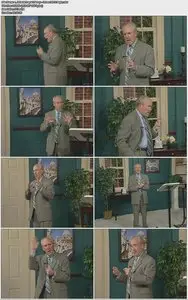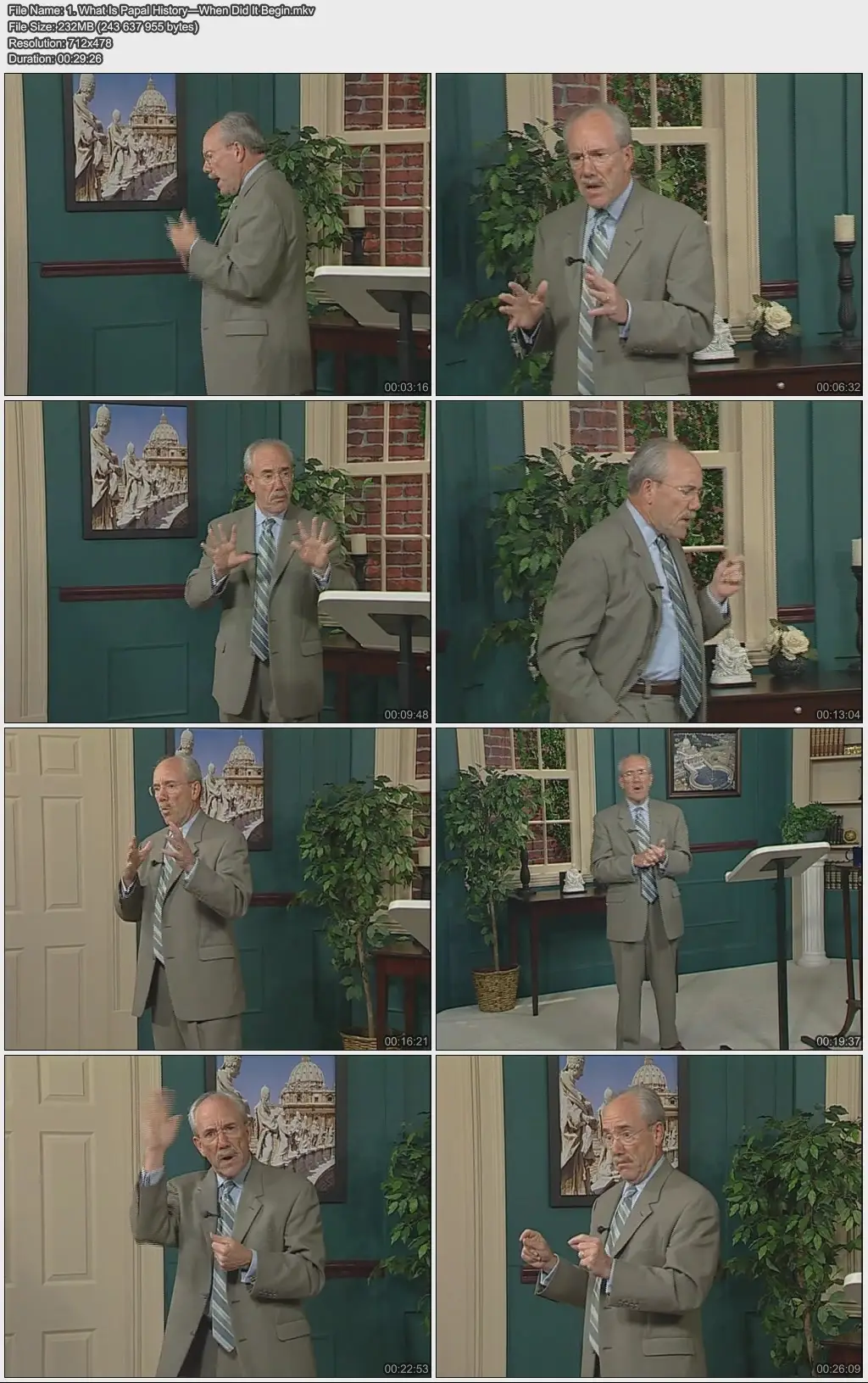TTC Video - Popes and the Papacy: A History (2006)
DVDRip | MKV / AVC 942 Kbps | 710х478 | 29.97 fps | AAC 128 kbps | 5.44 GB
Language: English | Run Time: 24x30 min
DVDRip | MKV / AVC 942 Kbps | 710х478 | 29.97 fps | AAC 128 kbps | 5.44 GB
Language: English | Run Time: 24x30 min
The papacy is the oldest continuously functioning institution in the world. Developed c. A.D. 30 when Jesus invested his disciple Peter with the authority to create a church, the Bishops of Rome grew their organization from a small flock of persecuted worshipers to a religion that counts one-sixth of the world's population as members.
Over the last 2,000 years, the papacy has had an enormous influence on the world stage in religious, geopolitical, legal, social, artistic, and cultural matters. Today, more than a billion Roman Catholics throughout the world look to the pope for guidance and leadership.
Yet in spite of the papacy's enormous influence, how much do you really know about this ancient and powerful institution?
How exactly are popes chosen?
What kinds of men have been included among the 265 who have borne the title?
What happened during the Great Schism and the decades of the Avignon Popes?
Is the Catholic Church really as wealthy as has been claimed?
What was the influence of the some three dozen antipopes who have laid claim to the papal office?
Was there really a female pope?
Why has the papacy proved so durable throughout history?
These and many other questions are answered in Popes and the Papacy: A History, a course designed to illuminate for Catholics and non-Catholics alike this remarkable institution. Taught by Professor Thomas F. X. Noble, a scholar and instructor who has spent more than 30 years engaged in scholarly studies of popes and the papacy, these 24 lectures give you priceless insights into the dramatic history of the papal office and the lives of the men who represented it.
Explore Four Unique Histories
"To study the history of the papacy is actually to follow four histories at once," notes Professor Noble at the start of the course. Throughout Popes and the Papacy, you follow four critical strands of papal history over the course of 2,000 years.
The History of the "Petrine" Idea: Taking its name from Peter, supposedly the first pope, the Petrine Office is how we talk about the theories behind the study of how and why the Catholic Church is organized as it is (what theologians call ecclesiology.)
The History of an Institution: The Catholic Church has one pope at a time (albeit sometimes there have been two or more men claiming to be the legitimate pope!), but the papacy is an institution that transcends time. We are familiar with separating presidents from the presidency; so too will you learn to distinguish popes from the papacy.
The History of Popes and Antipopes: You also follow the serial biography of 265 popes—some holy, some wicked, some efficient, some incompetent, some learned, some simple, some visionary, some narrow-minded—and the more than 30 antipopes from 217 to 1447.
The History of Western Civilization: In some ways, the history of the papacy is a mirror of the history of Western civilization; at every great moment in history, the popes were there as participants, promoters, or critics. Viewing Western civilization through a papal lens provides you with unique perspectives on historical events like the fall of the Roman Empire, the Renaissance, World War II, and the collapse of Communism.
Encounter History's Great Popes
In Popes and the Papacy, you discover the stories of the numerous men who defined the papacy, starting with its founder, Peter, and traveling through the current pope, Benedict XVI, elected in April of 2005. While some popes were remarkable, interesting, impressive, and memorable, others were regrettable. Others still were forgettable.
Professor Noble, the Robert M. Conway Director of the Medieval Institute and Professor of History at the University of Notre Dame, offers thoughts on why particular popes attract our attention and key insights into the legacies of their leadership.
Pope Gregory I, or Gregory the Great (r. 590–604) is the first pope about whom a great deal is known. In 596, he launched the reconversion of England.
Pope Sylvester II (r. 999–1003) was the first French pope and took the name Sylvester to symbolize the ideal of papal-imperial cooperation between Pope Sylvester I and Emperor Constantine.
Pope Julius II, (r. 1503–1513) personally led his troops into battle in an effort to enlarge the Papal States, yet this warrior-pope's contributions to the Renaissance included commissioning Michelangelo to paint the ceiling of the Sistine Chapel and hiring famed architect Donato Bramante to design St. Peter's Basilica.
Pope Pius X (r. 1903–1914), though he condemned the emerging ideas of Modernism, was also the greatest reformer of his age who instituted numerous changes in the Catholic Church, including the reinstitution of traditional church music.
In addition to these and other papal leaders, you'll ponder issues central to their rule, including whether recent history's criticism of Pope Pius XII's actions with respect to the Holocaust were justified, what made Pope John Paul II such a towering figure on the world stage, and what history can expect from the rule of the current pontificate of Pope Benedict XVI.
Look inside the Vatican's Doors
According to Professor Noble, the Vatican—the governing center of the Roman Catholic faith—is a pretty mysterious place. Nevertheless, he says that "today we can describe the Vatican in a lot more detail than was possible in the past … we just know a lot more about what happens and who does what."
Popes and the Papacy takes you inside the Vatican's doors and provides you with fresh views on the institution's people, ideas, traditions, and routines. You discover the important roles played by organizations like the Curia and the Secretariat of State. You also investigate the mechanisms by which the Church not only ministers to its worldwide flock but also deals with the practical realities of its own administration.
Enjoy a Wealth of Extraordinary Stories
The rich subject matter of Popes and the Papacy, spanning over 2,000 years of human civilization, provides you with a wealth of extraordinary stories that reflect the dramatic history of this important institution. Throughout the lectures, you:
Learn that when Pope Paul II instituted the first printing press in Rome in the 15th century, the resulting unemployment among the abbreviatori (the scribes who had previously produced copies of papal documents by hand) was so great that it resulted in a short-lived plot against the pope's life
Enjoy a glimpse into the Society of Jesus (the Jesuits), whose history has been far different from the peaceful one many people might associate with their teaching role
Discover why cardinals electing a new pope are actually locked in until their work is completed, a tradition that dates back to the 13th-century attempt to choose a successor to Clement IV
Stories like these—along with the wisdom of Professor Noble's 30 years of immersion in the subject—give every lecture of Popes and the Papacy a level of fascination that promises to educate, enlighten, and entertain you.
How exactly are popes chosen?
What kinds of men have been included among the 265 who have borne the title?
What happened during the Great Schism and the decades of the Avignon Popes?
Is the Catholic Church really as wealthy as has been claimed?
What was the influence of the some three dozen antipopes who have laid claim to the papal office?
Was there really a female pope?
Why has the papacy proved so durable throughout history?
These and many other questions are answered in Popes and the Papacy: A History, a course designed to illuminate for Catholics and non-Catholics alike this remarkable institution. Taught by Professor Thomas F. X. Noble, a scholar and instructor who has spent more than 30 years engaged in scholarly studies of popes and the papacy, these 24 lectures give you priceless insights into the dramatic history of the papal office and the lives of the men who represented it.
Explore Four Unique Histories
"To study the history of the papacy is actually to follow four histories at once," notes Professor Noble at the start of the course. Throughout Popes and the Papacy, you follow four critical strands of papal history over the course of 2,000 years.
The History of the "Petrine" Idea: Taking its name from Peter, supposedly the first pope, the Petrine Office is how we talk about the theories behind the study of how and why the Catholic Church is organized as it is (what theologians call ecclesiology.)
The History of an Institution: The Catholic Church has one pope at a time (albeit sometimes there have been two or more men claiming to be the legitimate pope!), but the papacy is an institution that transcends time. We are familiar with separating presidents from the presidency; so too will you learn to distinguish popes from the papacy.
The History of Popes and Antipopes: You also follow the serial biography of 265 popes—some holy, some wicked, some efficient, some incompetent, some learned, some simple, some visionary, some narrow-minded—and the more than 30 antipopes from 217 to 1447.
The History of Western Civilization: In some ways, the history of the papacy is a mirror of the history of Western civilization; at every great moment in history, the popes were there as participants, promoters, or critics. Viewing Western civilization through a papal lens provides you with unique perspectives on historical events like the fall of the Roman Empire, the Renaissance, World War II, and the collapse of Communism.
Encounter History's Great Popes
In Popes and the Papacy, you discover the stories of the numerous men who defined the papacy, starting with its founder, Peter, and traveling through the current pope, Benedict XVI, elected in April of 2005. While some popes were remarkable, interesting, impressive, and memorable, others were regrettable. Others still were forgettable.
Professor Noble, the Robert M. Conway Director of the Medieval Institute and Professor of History at the University of Notre Dame, offers thoughts on why particular popes attract our attention and key insights into the legacies of their leadership.
Pope Gregory I, or Gregory the Great (r. 590–604) is the first pope about whom a great deal is known. In 596, he launched the reconversion of England.
Pope Sylvester II (r. 999–1003) was the first French pope and took the name Sylvester to symbolize the ideal of papal-imperial cooperation between Pope Sylvester I and Emperor Constantine.
Pope Julius II, (r. 1503–1513) personally led his troops into battle in an effort to enlarge the Papal States, yet this warrior-pope's contributions to the Renaissance included commissioning Michelangelo to paint the ceiling of the Sistine Chapel and hiring famed architect Donato Bramante to design St. Peter's Basilica.
Pope Pius X (r. 1903–1914), though he condemned the emerging ideas of Modernism, was also the greatest reformer of his age who instituted numerous changes in the Catholic Church, including the reinstitution of traditional church music.
In addition to these and other papal leaders, you'll ponder issues central to their rule, including whether recent history's criticism of Pope Pius XII's actions with respect to the Holocaust were justified, what made Pope John Paul II such a towering figure on the world stage, and what history can expect from the rule of the current pontificate of Pope Benedict XVI.
Look inside the Vatican's Doors
According to Professor Noble, the Vatican—the governing center of the Roman Catholic faith—is a pretty mysterious place. Nevertheless, he says that "today we can describe the Vatican in a lot more detail than was possible in the past … we just know a lot more about what happens and who does what."
Popes and the Papacy takes you inside the Vatican's doors and provides you with fresh views on the institution's people, ideas, traditions, and routines. You discover the important roles played by organizations like the Curia and the Secretariat of State. You also investigate the mechanisms by which the Church not only ministers to its worldwide flock but also deals with the practical realities of its own administration.
Enjoy a Wealth of Extraordinary Stories
The rich subject matter of Popes and the Papacy, spanning over 2,000 years of human civilization, provides you with a wealth of extraordinary stories that reflect the dramatic history of this important institution. Throughout the lectures, you:
Learn that when Pope Paul II instituted the first printing press in Rome in the 15th century, the resulting unemployment among the abbreviatori (the scribes who had previously produced copies of papal documents by hand) was so great that it resulted in a short-lived plot against the pope's life
Enjoy a glimpse into the Society of Jesus (the Jesuits), whose history has been far different from the peaceful one many people might associate with their teaching role
Discover why cardinals electing a new pope are actually locked in until their work is completed, a tradition that dates back to the 13th-century attempt to choose a successor to Clement IV
Stories like these—along with the wisdom of Professor Noble's 30 years of immersion in the subject—give every lecture of Popes and the Papacy a level of fascination that promises to educate, enlighten, and entertain you.
1. What Is Papal History? When Did It Begin?
2. The Rise of the Petrine Idea
3. Popes, Byzantines, and Barbarians
4. The Popes in the Age of Charlemagne
5. Rome, the Popes, and the Papal Government
6. The “Age of Iron”
7. The Investiture Controversy
8. The Papal Monarchy—Institutions
9. The Papal Monarchy—Politics
10. The Popes at Avignon
11. The Great Schism
12. The Renaissance Papacy—Politics
13. The Renaissance Papacy—Culture
14. The Challenge of Reform—Protestantism
15. Catholic Reform and Counter Reform
16. Absolutism, Enlightenment, and Revolution
17. Pius IX—Prisoner of the Vatican
18. The Challenge of Modernism
19. The Troubled Pontificate of Pius XII
20. The Age of Vatican II
21. The Transitional Pontificate of Paul VI
22. The Vatican and What It Does
23. John Paul II—“The Great”?
24. Benedict XVI, the Future, and the Past
Professor Thomas F. X. Noble







